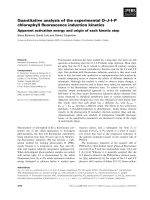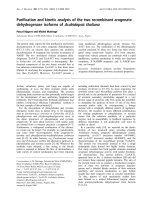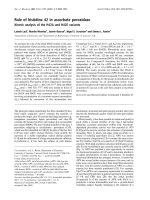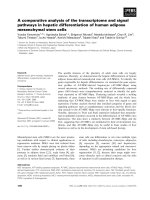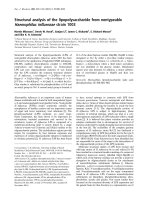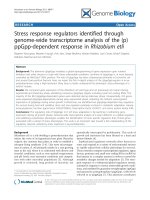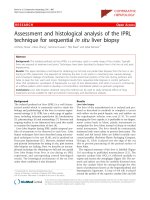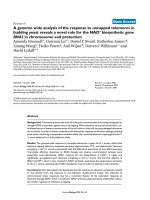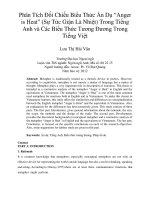Kinetic analysis of the main thermoluminescence glow peak in α-Al2O3
Bạn đang xem bản rút gọn của tài liệu. Xem và tải ngay bản đầy đủ của tài liệu tại đây (5.16 MB, 8 trang )
Radiation Measurements 153 (2022) 106749
Contents lists available at ScienceDirect
Radiation Measurements
journal homepage: www.elsevier.com/locate/radmeas
Kinetic analysis of the main thermoluminescence glow peak in α-Al2O3
Yulissa Espitia a, Rafael Cogollo a, *, Amalia Osorio a, Omar D. Guti´errez b
a
Grupo de Materiales y Física Aplicada, Departamento de Física, Universidad de C´
ordoba, Cra. 6 # 76-103, Montería, 230002, Colombia
Grupo de Química B´
asica, Aplicada y Ambiente, Facultad de Ciencias Exactas y Aplicadas, Instituto Tecnol´
ogico Metropolitano, Calle 73 No. 76A – 354, Medellín,
050034, Colombia
b
A R T I C L E I N F O
A B S T R A C T
Keywords:
Al2O3
Thermoluminescence
Kinetic-parameters
Dose-response
Reproducibility
In this work the kinetic parameters of the main peak of the TL glow curve of alumina (α-Al2O3) irradiated at
different doses are reported. Samples were irradiated at different X-ray doses using a 6 MeV linear accelerator
(LINAC), in air at room temperature. The Initial rise, peak shape, whole glow peak and curve fitting methods
were used for the kinetic analysis. The glow curves of the α-Al2O3 samples exhibited a total of three experimental
glow peaks, the main peak located between 160 and 170 ◦ C. The behavior of the kinetic parameters (activation
energy E, frequency factor s and order parameter b) of the main peak of the TL glow curve, is independent of the
radiation dose received by the material.
1. Introduction
parameters of α-Al2O3 matrices doped with Cerium (Al2O3:Ce). The in
crease of Ce affected the shape of the curve, the positions of its peaks and
in general the trapping parameters. In addition, it generated new traps in
the material, which became evident by the appearance of new peaks or
TL signals in the glow curve.
This work contributes by addressing simultaneously: the thermolu
minescent behavior (via its kinetic analysis) and the dosimetric behavior
of the α-Al2O3 matrix, presenting in the first case a discussion on the
kinetic parameters obtained with various methods in order to conclude
which is the most suitable to use as a starting point in the understanding
of thermoluminescent recombination and re-trapping processes. Com
plementing the above, the dosimetric study provides fundamental as
pects to validate the implementation of α-Al2O3 as a TL dosimeter in a
real application. The scientific (TL kinetic analysis) and technological
(dosimetric analysis) approaches considered here seek to contribute
towards the development of new alumina-based TL dosimeters.
Aluminum oxide (α-Al2O3) has been reported in the literature for use
as a thermoluminescent (TL) dosimeter, in clinical, personal and envi
ronmental monitoring of ionizing radiation (Duggan et al., 2000; Kortov
´r et al., 2001; Osorio et al., 2012; Papin et al.,
and Milman, 1996; Molna
1996; Rocha et al., 2003). Alumina has been used as a host matrix in
thermoluminescent materials with different doping (Duggan et al.,
2000; Kalita and Chithambo, 2017; Rojas et al., 2019). In all cases the
material retained its most prominent TL properties, such as its sensi
tivity, but also maintained thermal fading as its major problem to be
solved (Osorio et al., 2012; Rocha et al., 2003).
P´erez Díaz et al. (2013) reported the calculation of the kinetic pa
rameters of α-Al2O3 samples by the three-point method (Rasheedy et al.,
2007) and by the Kitis curve fitting technique using the four-parameter
logistic asymmetric function (Pagonis and Kitis, 2002). By both
methods, recombination processes were found to take primacy over
re-trapping processes in the α-Al2O3 matrix, although mixed behavior
was found in the intermediate region of the glow curve.
Kalita and Chithambo (2017) investigated the influence of dose
(0.1–100 Gy) on the kinetic parameters and dosimetric characteristics of
the main glow peak of α-Al2O3:C,Mg, using several methods for kinetic
analysis of TL glow curves. They found that the activation energy and
kinetic order are independent of the dose of beta radiation received
between 0.1 and 100 Gy.
Rojas et al. (2019) reported the calculation of the trapping
2. Experimental methods
The procedure described by Osorio et al. (2012) and Rojas et al.
(2019) was used for sample preparation: alumina boehmite powders
(99.995%, W. R. Grace & Co-Conn), were used to prepare pellets of 30
mg with a diameter of 5 mm and 1 mm of thickness by uniaxial pressing
at 27.6 MPa for 30 s. Afterwards, the samples were heated at 1 ◦ C/min
from room temperature up to 1000 ◦ C and sintered for 3 h. In order to
validate the reproducibility of the thermoluminescent behavior, two
* Corresponding author.
E-mail address: (R. Cogollo).
/>Received 1 December 2021; Received in revised form 17 March 2022; Accepted 22 March 2022
Available online 25 March 2022
1350-4487/© 2022 Elsevier Ltd. All rights reserved.
Y. Espitia et al.
Radiation Measurements 153 (2022) 106749
replicates (called ALO3 and ALO5) obtained with the treatment
described above were studied in this work.
The sintered pellets were irradiated in triplicate (dose of 200, 400,
500, 700 and 1000 cGy) in an air atmosphere at room temperature using
a linear accelerator (Clinac 600, 6 MeV, irradiation dose rate of 100
cGy/min) at Instituto M´
edico de Alta Tecnología-IMAT in Montería,
Colombia. The samples were positioned at 100 cm from the source inside
a radiation field of 10 × 10 cm2 in the irradiation plane (Rojas et al.,
2019). The pellets were placed between two 5-mm-thick acrylic sheets
in order to create conditions of electronic equilibrium. Samples were
heated at 5 Ks− 1 in a Harshaw TLD 4500 Reader (Bicron®) between 50
and 400 ◦ C. All the readings were carried out in nitrogen atmosphere. To
remove residual signal from the material, before each irradiation,
samples were annealed at 400 ◦ C for 1 h, followed by cooling in air to
room temperature (Rojas et al., 2019).
bars correspond to the standard deviation of the average Tm obtained.
3.3. Kinetic analysis
3.3.1. Initial rise method
Fig. 3 shows the plot of ln(I) versus 1/kT for the initial rise part (up to
15% of the maximum intensity) of the main peak recorded for ALO3 and
ALO5 irradiated at different doses (β = 5 Ks− 1). From these plots, the
activation energies were calculated and reported in Table 1.
For ALO3 and ALO5, the activation energy values (E) fall within ±
two standard deviations of the average value reported in Table 1. The E
values for the ALO5 sample show the same behavior as with ALO3, since
for the lowest doses (200 and 400 cGy) the activation energy takes
similar values, but for the highest doses it decreases with respect to the
first ones. As the temperatures at which the maximum intensity (Tm) is
found are different, the activation energy values also differ because Tm is
associated with the depth of the energy trap. For sample ALO3 the Tm is
437.15 K for the lowest doses but decreases to 435.15 K for the highest
doses (700 and 1000 cGy).
3. Results and discussion
3.1. Glow curve features
Fig. 1 shows the glow curve of the sintered α-Al2O3 pellet called
ALO3 and ALO5, irradiated at 1000 cGy, read between 50 and 400 ◦ C (β
= 5 Ks− 1).
In the temperature range used, the curve exhibits three glow peaks
around 162 ◦ C, 265 ◦ C and 338 ◦ C respectively for ALO3. For sample
ALO5 the glow curve is similar but with a slight shift in the position of
the glow peaks. Three peaks are observed at 169 ◦ C, 273 ◦ C and 346 ◦ C
respectively. Although the samples were prepared under identical con
ditions, the ALO3 sample is lower intensity than sample ALO5.
3.3.2. Peak shape method
Starting from the geometrical shape parameters (Fig. 4) τ, δ and ω
defined in this method (Pagonis et al., 2006) and the expressions
developed by Chen (Pagonis et al., 2006) to calculate the activation
energies Eτ, Eδ and Eω associated with these geometric parameters.
Table 2 shows the results obtained with the peak shape method for ALO3
and ALO5 (β = 5 Ks− 1). The values of the geometric shape factor μ
corresponding to the main peak are between 0.45 ± 0.04 and 0.50 ±
0.07, indicating a general order kinetics for all the doses studied being
consistent with Rojas et al. (2019). The values of the activation energy
Eτ are between 0.96 and 1.06 eV for sample ALO3 and 0.99 and 1.10 eV
for ALO5. It can be seen that the energy values calculated using τ are
closer to those estimated with the IR method.
3.2. Dependence of peak position on dose for the main glow peak
Fig. 2 shows to the glow curves for samples ALO3 and ALO5 irradi
ated to different doses. The signal intensity increases proportionally
with dose. Inset shows that there is a shift in the position of the TL peak,
suggesting that main peak follows a general order kinetic or it is a
combination of multiple peaks. This last one option is discarded since
the curve fitting method (see section 3.3.4) shows a single peak. Error
3.3.3. Whole glow peak method
This method is based on the measurement of the integral n(T) of the
TL intensity over a certain temperature region. May and Partridge and
Muntoni (Pagonis et al., 2006) deduced for a general order kinetics the
Fig. 1. Glow curves of sintered alumina pellets irradiated at a dose of 1000 cGy.
2
Y. Espitia et al.
Radiation Measurements 153 (2022) 106749
Fig. 2. Glow curves of samples recorded at 5 ◦ C/s after irradiation at different doses for: (a) ALO3 and (b) ALO5. The inset shows the change in the position of the
main peak with irradiation dose.
expression: ln(nIb ) = ln(βs ) −
E
kT .
maximum order of 1010 s− 1, being agree with those predicted in the
kinetic theory. In ALO5 the values of b (1.10) corresponding to 200, 400,
700 and 1000 cGy indicate that the main peak follows a first order ki
netics as a mechanism of deactivation of the energetic traps, while as in
the previous case, for 500 cGy b = 1.3 evidences a general order kinetics.
The value of the activation energy obtained with this method is
consistent with the results obtained by the initial rise method and with
the energy values Eτ, obtained by the peak shape method especially for
the lower doses.
To obtain the kinetic order (b) several
lines are drawn with various values of b and the best straight line is
chosen. As an example Fig. 5 shows the plots obtained with different
values of b for samples ALO3 and ALO5 irradiated with 200 cGy.
Table 3 shows the results obtained with the whole glow peak method
indicating the kinetic order which best fitted the data for all doses (β = 5
Ks− 1).
In ALO3 the best linear fit was achieved with b = 0.90 (for 400 and
700 cGy), b = 1.00 (for 200 and 1000 cGy), and b = 1.20 (500 cGy). In
all cases R2 have a value of 0.99. The values of b corresponding to doses
of 200, 400, 700 and 1000 cGy indicate that the main peak follows first
order kinetics while for the 500 cGy dose it follows general order ki
netics. The activation energy values coincide with those obtained with
the initial rise method. The values of the frequency factors (s) are of a
3.3.4. Curve fitting method
Glow curves were fitted with the expressions developed by Pagonis
et al. (2006) for general-order kinetics. Table 4 and Figs. 6 and 7 present
the results obtained with the curve fitting method for samples ALO3 and
3
Y. Espitia et al.
Radiation Measurements 153 (2022) 106749
Fig. 3. ln(I) vs. 1/kT plots for the initial rise portion of the main peak at different doses for: (a) ALO3 and (b) ALO5.
Table 1
Activation energy obtained with IR method.
Dose
(cGy)
ALO3
Tm (K)
Im (a.u)
E (eV)
200
437.15
232771
400
437.15
470483
500
437.15
577057
700
435.15
828261
1000
435.15
1.20E+06
0.950
0.008
0.950
0.008
0.983
0.010
0.888
0.016
0.852
0.017
Table 2
Activation energy obtained with PS method.
ALO5
ALO3
Tm(K)
Im (a.u)
E (eV)
±
444.15
296857
±
444.15
598693
±
443.15
732767
±
442.15
1.06E+06
±
442.15
1.59E+06
1.05 ±
0.01
1.05 ±
0.01
1.08 ±
0.01
0.98 ±
0.01
0.93 ±
0.01
Dose
(cGy)
Tm (K)
Im (a.u)
μ ±Δμ
Eτ (eV)
Eδ (eV)
Eω (eV)
200
437.15
232771
400
437.15
470483
500
437.15
577057
700
435.15
828261
1000
435.15
1.20E+06
0.50 ±
0.04
0.47 ±
0.04
0.45 ±
0.04
0.47 ±
0.04
0.50 ±
0.07
1.06 ±
0.06
1.06 ±
0.06
0.96 ±
0.05
1.05 ±
0.05
1.05 ±
0.05
0.76 ±
0.04
0.85 ±
0.05
0.85 ±
0.05
0.84 ±
0.05
0.84 ±
0.01
0.91 ±
0.03
0.96 ±
0.03
0.91 ±
0.03
0.95 ±
0.03
0.95 ±
0.03
ALO5
Dose
(cGy)
Tm (K)
Im (a.u)
μ ±Δμ
Eτ (eV)
Eδ (eV)
Eω (eV)
200
444.15
296857
400
444.15
598693
500
443.15
732767
700
442.15
1.06E+06
1000
442.15
1.59E+06
0.45 ±
0.03
0.48 ±
0.03
0.47 ±
0.03
0.48 ±
0.03
0.48 ±
0.03
1.06 ±
0.06
1.10 ±
0.05
0.99 ±
0.04
1.04 ±
0.05
1.04 ±
0.05
1.08 ±
0.06
1.13 ±
0.06
1.02 ±
0.05
1.07 ±
0.05
1.07 ±
0.05
1.08 ±
0.03
1.12 ±
0.03
1.08 ±
0.03
1.06 ±
0.02
1.06 ±
0.03
results indicate that ALO5, like ALO3, follows a general order mecha
nism where recombination takes precedence over retrapping. The fre
quency factor is around 1012 s− 1, close to that predicted by kinetic
theory. The kinetic parameters show a dose-independent behavior as
with ALO3.
Based on the above methods and their results, it is evident that the
value of the activation energy of the main energy trap of the glow curve
of the alumina matrices used is around 1.00 eV, regardless of the
absorbed dose. Regarding parameter b, the values obtained (b~1.32)
with the whole glow peak and curve fitting methods seem to be more
consistent because in addition to having lower variability, they are in
line with those reported in the literature (P´erez Díaz et al., 2013; Rojas
et al., 2019).
Fig. 4. The geometrical shape parameters τ, δ, ω and μ defined for a
glow curve.
ALO5. It can be seen that the FOM (figure of merit) values were less than
5% in all cases, validating the kinetic parameters obtained with the
curve fitting method, and also validating the application of initial rise,
peak shape and whole glow peak methods, since the main peak is
composed of a single TL peak. For ALO3 a mean value of E of (1.08 ±
0.01) eV was determined; an order of kinetics b with a mean value of
1.35 ± 0.01 and the frequency factors being of a maximum order of 1011
s− 1. The mean value of b evidences a general order kinetics as a mech
anism of deactivation of the energetic traps, where recombination takes
precedence over retrapping, as concluded in the previous methods. The
results obtained are similar with increasing dose, indicating that the
kinetic parameters are independent of the dose. For ALO5, E and b have
a mean value of (1.16 ± 0.03) eV and 1.33 ± 0.01 respectively. These
3.4. Dosimetric analysis
Fig. 8(a) shows the variation of the maximum peak intensity as a
function of dose, where a linear behavior is observed from 200 cGy to
1000 cGy for ALO3 and ALO5. The dose response can be fitted quite
well, over the dose range used, with a linear equation of the form:
4
Y. Espitia et al.
Radiation Measurements 153 (2022) 106749
Table 4
Kinetic parameters obtained with curve fitting method.
ALO3
Dose (cGy)
Tm (K)
Im (a.u)
E (eV)
s (s− 1)
b
FOM
200
400
500
700
1000
437.71
437.77
436.43
435.10
435.70
232771
470483
577057
828261
1.20E+06
1.09
1.09
1.08
1.07
1.07
2.42E+11
2.28E+11
2.12E+11
1.78E+11
1.70E+11
1.37
1.36
1.37
1.33
1.33
3.11%
3.23%
3.25%
4.15%
4.03%
ALO5
Dose (cGy)
Tm (K)
Im (a.u)
E (eV)
s (s− 1)
b
FOM
200
400
500
700
1000
443.20
443.22
443.85
443.21
442.30
296562
598693
732767
1.06E+06
1.59E+06
1.10
1.10
1.16
1.10
1.10
2.11E+11
2.35E+11
1.14E+12
1.59E+11
2.50E+11
1.32
1.32
1.35
1.35
1.34
2.27%
2.32%
4.14%
3.82%
3.77%
S(D) = a + cD
(1)
Where D is the given dose, a = − 16093.8 and c = 1210.4 for sample
ALO3 and a = − 49850.6 and c = 1616.9 for ALO5.
3.4.1. Reproducibility
An optimum TL material for dosimetry should have an uncertainty in
its measurements no greater than 4% after repeating up to ten or twelve
continuous reading cycles (Azorín Nieto, 1993). To study reproduc
ibility, the ALO3 samples were subjected to ten identical reading cycles
using the same conditions: thermal bleaching, irradiation and reading.
The doses administered were 50 and 100 cGy. Fig. 9 shows that the
results for each group of measurements present approximately the same
dispersion. In each case, the data are normalized to the mean value of all
measurements. In the first case it is found that the uncertainty associated
with respect to the mean value of the measurements has a value of 2.4%,
while in the second case the uncertainty in the measurements with
respect to the mean value is 2.3%.
Fig. 5. ln(I/nb) vs. 1/kT with different values of kinetic order (b) for: (a) ALO3,
(b) ALO5 (200 cGy). The best linear fit were achieved for b = 1 (ALO3, R2 =
0.99) and b = 1.1 (ALO5, R2 = 0.99).
3.4.2. Fading
To study the thermal fading of the signal, one single ALO3 sample
was irradiated at a dose of 50 cGy, stored at ambient conditions and read
during the 30 days following irradiation, at regular time intervals. Three
days after irradiation, the ALO3 pellet showed a signal fading of 18%.
Six days after irradiation, the signal fading was 25%. After 10 days, the
sample showed a signal fading of 28%. 21 days later it reached 36% and
finally stabilized at 40% twenty-five days after irradiation. The high
decrease in response may be related to the storage conditions: high
relative humidity (70%) and high ambient temperature (32 ± 4 ◦ C).
Regarding this fading phenomenon, Kalita and Chithambo (2017)
studied α-Al2O3:C and α-Al2O3:C, Mg matrices, finding that carbon and
magnesium induced the formation of five (α-Al2O3:C) and seven
(α-Al2O3:C,Mg) energy traps with similar activation energies, in which
Kalita and Chithambo (2017) propose charge hopping between traps as
an explanation for the fading phenomenon at room temperature. In the
present study (α-Al2O3), given the high storage temperature (32 ± 4 ◦ C)
and the calculated activation energy values for the trap associated with
the main peak, charge hopping may also be one of the feasible expla
nations for the fading.
Table 3
Kinetic parameters obtained with whole glow peak method.
ALO3
Dose
(cGy)
Tm (K)
Im (a.u)
E (eV)
s (s− 1)
b
R2
200
437.15
232771
0.99
437.15
470483
0.90
0.99
500
437.15
577057
1.20
0.99
700
435.15
828261
0.90
0.99
1000
435.15
1.20E+06
(7.70 ± 0.29)
E+09
(8.42 ± 0.43)
E+10
(1.12 ± 0.47)
E+09
(7.01 ± 2.11)
E+09
(1.78 ± 0.36)
E+09
1.00
400
0.96 ±
0.01
0.97 ±
0.01
0.99 ±
0.01
0.88 ±
0.01
0.89 ±
0.01
1.00
0.99
ALO5
Dose
(cGy)
Tm (K)
Im (a.u)
E (eV)
s (s− 1)
b
R2
200
444.15
296857
0.99
444.15
598693
1.10
0.99
500
443.15
732767
1.30
0.99
700
442.15
1.06E+06
1.10
0.99
1000
442.15
1.59E+06
(4.20 ± 1.42)
E+10
(3.88 ± 1.42)
E+10
(2.38 ± 1.08)
E+09
(2.85 ± 1.08)
E+09
(8.65 ± 1.41)
E+08
1.10
400
1.06 ±
0.01
1.06 ±
0.01
1.08 ±
0.01
0.97 ±
0.01
0.93 ±
0.01
1.10
0.99
3.4.3. Detection limit
The minimum dose given to the ALO3 samples was 2 cGy. In all cases
the samples exhibited a glow curve similar to that observed for high
doses. Measurements in this range presented an uncertainty of 4.7%. It
should be noted that 2 cGy is the minimum dose administered by the
radiation equipment.
5
Y. Espitia et al.
Radiation Measurements 153 (2022) 106749
Fig. 6. Results of curve fitting method for the main peak of ALO3 irradiated at different doses.
Fig. 7. Results of curve fitting method for the main peak of ALO5 irradiated at different doses.
4. Conclusions
The effect of dose on the kinetic parameters of the main glow peak of
an alumina (α-Al2O3) sample has been studied using several methods.
The results show that the kinetic parameters, E, b and s of the main peak
are dose independent. The main peak follows general order kinetics with
recombination as the main read-out mechanism.
In general, for all irradiation doses, the value of the activation energy
The glow curves of the alumina samples exhibit three peaks around
162 ◦ C, 265 ◦ C and 338 ◦ C for ALO3 and around 169 ◦ C, 273 ◦ C and
346 ◦ C for ALO5. The main peak is located at 162 ◦ C and 169 ◦ C
respectively.
6
Y. Espitia et al.
Radiation Measurements 153 (2022) 106749
Fig. 8. (a) Maximum peak intensity as a function of the dose from 200 to 1000 cGy, (b) Area of the main peak of the glow curve as a function of the dose from 200 to
1000 cGy.
Fig. 9. The peak intensity of the main peak of ALO3 for 10 repeated identical measurements for different irradiation doses.
is around 1.00 eV.
The response of the material with dose is linear in the range used
(≤10 Gy), showing a signal fading of 32% after 10 days of irradiation.
Reproducibility analysis shows that the alumina (α-Al2O3) samples
reproduce their response under identical experimental conditions with
an uncertainty of 2.3%.
Declaration of competing interest
The authors declare that they have no known competing financial
interests or personal relationships that could have appeared to influence
the work reported in this paper.
Acknowledgements
The authors acknowledge the financial support received from
7
Y. Espitia et al.
Radiation Measurements 153 (2022) 106749
´rdoba at Montería and Instituto Tecnolo
´gico Metro
Universidad de Co
politano at Medellín.
Pagonis, V., Kitis, G., 2002. Fit of second order thermoluminescence glow peaks using the
logistic distribution function. Radiat. Protect. Dosim. 101, 93–98.
Pagonis, V., Kitis, G., Furetta, C., 2006. Numerical and Practical Exercises in
Thermoluminescence, first ed. Springer New York, New York, NY. />10.1007/0-387-30090-2.
Papin, E., Grosseau, P., Guilhot, B., Benabdesselam, M., Iacconi, P., Lapraz, D., 1996.
Influence of the calcining conditions on the thermoluminescence of pure and doped
Alpha-alumina powders. Radiat. Protect. Dosim. 65, 243–246. />10.1093/oxfordjournals.rpd.a031632.
P´
erez Díaz, M.E., Cogollo Pitalúa, R.R., Guti´
errez Fl´
orez, O.D., 2013. Determination of
the kinetic parameters of thermoluminescent glow curves of sintered Al2O3 pills by
three points method. Rev. la Acad. Colomb. Ciencias 37, 95–99.
Rasheedy, M.S., El-Sherif, M.A., Hefni, M.A., 2007. Determination of the trapping
parameters of thermoluminescent glow peaks of K2YF5:Ce by three points method.
Nucl. Instrum. Methods Phys. Res. Sect. B Beam Interact. Mater. Atoms 258,
440–444. />Rocha, F.D.G., Oliveira, M.L., Caldas, L.V.E., 2003. Thin sintered Al2O3 pellets as
thermoluminescent dosimeters for the therapeutic dose range. Appl. Radiat. Isot. 58,
719–722. />Rojas, J., Cogollo, R., Gil, M., Usma, J., Guti´errez, O., Soto, A., 2019. Cerium and
manganese doped alumina matrices: preparation, characterization and kinetic
analysis of their glow curves. J. Lumin. 214, 116572. />jlumin.2019.116572.
References
´pticas de los
Azorín Nieto, J., 1993. Estudio de las propiedades termoluminiscentes y o
principales materiales dosim´etricos. Universidad Aut´
onoma Metropolitana
-Iztapalapa.
Duggan, L., Budzanowski, M., Przegietka, K., Reitsema, N., Wong, J., Kron, T., 2000. The
light sensitivity of thermoluminescent materials: LiF:Mg,Cu,P, LiF:Mg,Ti and Al2O3:
C. Radiat. Meas. 32, 335–342. />Kalita, J.M., Chithambo, M.L., 2017. Comprehensive kinetic analysis of
thermoluminescence peaks of α-Al2O3 :C,Mg. J. Lumin. 185, 72–82. />10.1016/j.jlumin.2017.01.003.
Kortov, V., Milman, I., 1996. Some new data on thermoluminescence properties of
dosimetric Alpha-Al203 crystals. Radiat. Protect. Dosim. 65, 179–184. https://doi.
org/10.1093/oxfordjournals.rpd.a031616.
Moln´
ar, G., Benabdesselam, M., Borossay, J., Lapraz, D., Iacconi, P., Akselrod, M., 2001.
Influence of the irradiation temperature on TL sensitivity of Al2O3. C. Radiat. Meas.
33, 619–623. />Osorio, A., Salcedo, J., Cogollo, R., 2012. Pastillas sinterizadas de Al2O3 como
dosímetros termoluminiscentes. Ing. y Cienc. 8, 47–64. />ingciencia.8.15.3.
8
